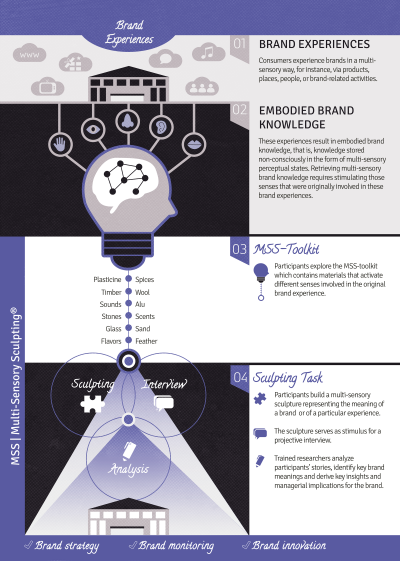Consumers often lack the ability to express multi-sensory
and non-conscious thoughts and feelings. Multi-Sensory Sculpting
is a qualitative market research method
that supports consumers in expressing this knowledge via metaphors.
MSS provides relevant insights for brand strategy and
brand touch-point development as well as for brand innovation.
MSS | MULTI-SENSORY SCULPTING
Why Multi-Sensory Sculpting ?
Consumers experience brands via products, places, people, or brand-related activities and
with multiple senses involving, vision, smell, touch, taste, audition or body movements, amongst others.
These experiences result in multi-sensory brand knowledge, that is,
knowledge stored in the form of multi-sensory cognitive images at a non-conscious level.
Retrieving multi-sensory brand knowledge requires stimulating those senses that were originally involved in the brand experiences,
since consumers often lack the ability to express non-verbal knowledge verbally (e.g., via questionnaires).
Multi-sensory Sculpting allows retrieving non-verbal knowledge
in a metaphoric format that resembles consumers’ multi-sensory cognitive images.
Awards received for Multi-Sensory Sculpting

E: Science Award of the City of Innsbruck 2014
Science Award of the City of Innsbruck 2014

E: Science award 2014 of the „Markenverband
Science award 2014 of the „Markenverband und Gesellschaft zur Erforschung des Markenwesens“ (2nd rank)

E: Young Researcher Award 2013
Young Researcher Award 2013 of the „Wissenschaftliche Kommission Marketing im Verband der Hochschullehrer für Betriebswirtschaft e. V.“

E: German Market Research Award / Preis der Deutschen Marktforschung 2012 – Best Paper
German Market Research Award / Preis der Deutschen Marktforschung 2012 - Best Paper
E: TIM –Triconsult Award for Innovative Market Research 2011, 2nd rank
TIM –Triconsult Award for Innovative Market Research 2011, 2nd rank

E: Best Student Paper Award 2011, University of Innsbruck
Best Student Paper Award 2011, University of Innsbruck
Multi-Sensory Sculpting has been published in the Journal of Business Research 2013.






